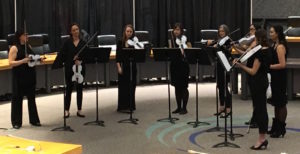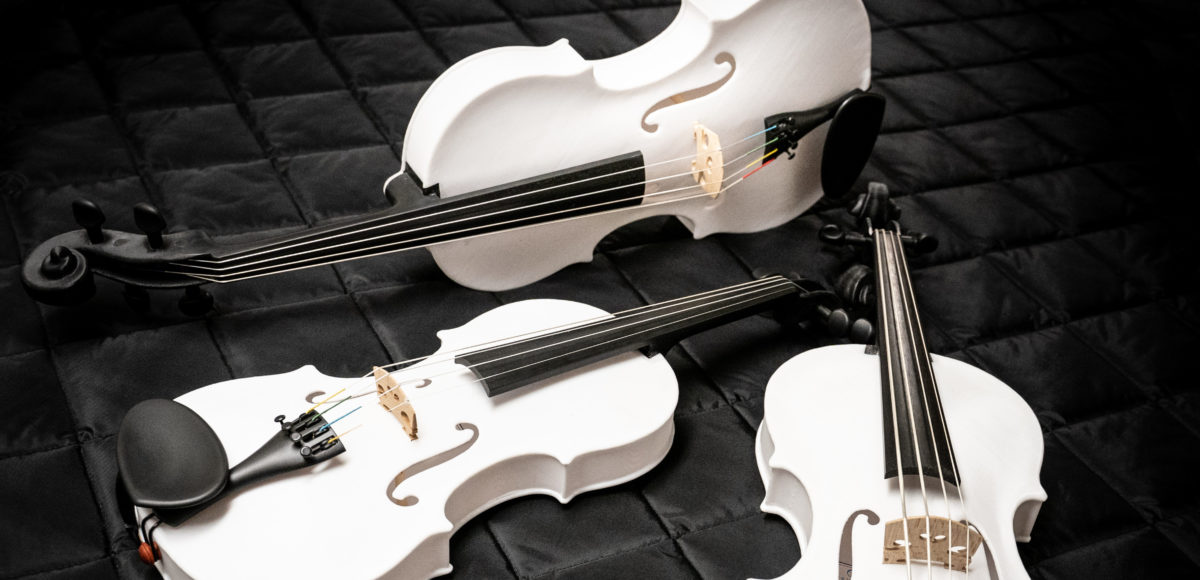The Ottawa Symphony Orchestra did more than did a toe in the future Sunday, the OSO dropped a cannonball and frankly made a pretty big splash.
The event was the opening concert of the OSO’s 2018-19 season and it was unique for several important reasons. First the concert was held in Jen Pigott Hall inside Ottawa City Hall beside a pool of water and looking at a United Way sign that read Inspiration.
Second the event was packed full of contemporary music … and contemporary sounding music.
But the real unveiling was the premiere performance of Montreal composer Harry Stafylakis’s piece called Singularity for Octet and Orchestra. The eight women in the octet played white and black 3D printed string instruments and the result provided for a surprising and entertaining early afternoon of music that capped almost three years of work, testing, failing and trying again to produce instruments that resemble violins and violas with the help of computers and a 3D printer.
One can only say so far, so pretty darn good.

Members of the Ottawa Symphony Orchestra prepare to play their 3D printed instruments in the City Hall council chamber. Photo: Peter Robb
The ever jovial maestro of the OSO, Alain Trudel, was at his talkative best on Sunday explaining each piece of music as it was performed.
This was not a “familiar” program. So the explanations helped set an understanding of the music played and, one hopes, open an accepting ear in the listening audience which was refreshingly diverse in demographics.
Kudos to the OSO for performing works by artists such as the Vancouver-based award winning composer Jeffrey Ryan (Violet Crumble) and the late American non-conformist and innovator Frank Zappa (Naval Aviation in Art?). Ryan, who was in attendance, provided a piece that was a sugar high of sounds.
There was a brief taste of a modern sounding work from the early 18th century by Jean Fery Rebel, a predecessor of Bach that opened the event and an exploration Octandre by the early 20th century composer Edgard Varese. This work for flute, oboe, clarinet, bassoon, horn, trumpet, trombone, and double bass, immediately preceded Stafylakis’ Singularity and provided a useful contrast for the listener.
The premiere of Singularity was also surprising for the ambition of the work. It tested these new instruments. Singularity featured a strong and hard-driving, almost cinematic presence of percussion and brass as a backdrop for the more delicate and pleasurable sounds emanating from the white and black 3D instruments. The octet was delicate and melodic with an interesting injection of a cello-like sound from two of the viola-like instruments that were equipped with heavier strings that allowed for a lower register.
Earlier in the day, curious listeners, and there were many, got a chance to hear the 3D instruments on their own in the council chamber.
Paired with a string quartet of traditional wooden instruments, the 3D octet played some of J.S. Bach’s The Art of the Fugue. There was a clear difference between the sound of the octet and the quartet. The wooden instruments were more resonant, more clear.
The 3D instruments were quieter, muted might be a better word. (Here is how they sound. In comparison, here is how the wooden string quartet sounded).
For Mary-Elizabeth Brown, the OSO concertmaster, though, the 3D instruments have been evolving and improving with each iteration produced over the past two years.
“Every prototype we have greeted has gotten easier to play. The first ones were really heavy to hold and they didn’t project well. This one here doesn’t project as well as a wooden instrument, but it is much easier to play now. It sounds very loud close to the ear but not so loud farther away.
“This is the first project of its kind and I think the sky is the limit given how it has evolved in the past 18 months.”
Brown is a teacher as well as a performer and she teaches many of her charges over Skype. When 3D printers are cheaper and more widely available, one can envisage printing an instrument in a far away classroom and exposing many more young people to the power of music, she said.
“I have been sort of eyeing these and thinking ‘Man, that would be a lot easier that flying an instrument into the Arctic Circle’.” One of her students does indeed reside in that region.
The current version of the instrument sits in her hand well, she says and does not cause any problems with her shoulder. All of which is good news fqor a violinist.
“We are getting there,” she said. “It feels well-balanced. It can be a little bit funny to play still, and I know that the girls with the bass violas had a challenge because the tension on the strings and neck is not the same as a wooden instrument.”
Some people were skeptical of the project at the beginning, she said, wondering if it was intended to replace wooden instruments. But, Brown is adamant on that point. “The project is not intended to replace our traditional instruments. It’s very much a complementary thing.” She says these instruments have the potential to be cheaper and more accessible than say a carbon fibre instrument.
Clarissa Klopoushak, who is a violinist with the NAC Orchestra leant a hand in the concert and in The wooden string quartet on Sunday. She was full of praise for the project.
“They are a wonderful marvel. It’s a really cool concept. This is the ninth prototype so far and I think right now in their current state they would make a fantastic educational tool. I can see this being applied widely in a Sistema program, for example, because they are inexpensive and will be easy to proliferate.
“At this point, I couldn’t see them in a professional orchestra. But I think they could make excellent electric instruments. As the material becomes more refined, then maybe they could keep up with the wood. But right now the wooden instrument have more resonance and projection.”
At a table in the hallway near the concert area, Dave Murray had just finished playing the very first prototype of the 3D instrument. He had heard about the event and wanted to see it for himself.
The House of Commons employee was suitably impressed with the idea, even while he found the prototype very heavy.
He said he believes it is a great idea to experiment with different aspects of music in the classical realm.
“Any innovation on something like the violin which has been around for hundreds of years is definitely very interesting. That sentiment of experimentation will drive the sector forward.”
He also can see the potential of an idea like this one making music much more accessible to many more people. And he said, that is one way to keep up attendance at concerts and overall interest in the classical form of music.
“I had the luxury of parents who made music a priority, but not everyone has that. Private lessons are expensive.”
The arts teach you how to express yourself, he said, and “anything that reduces the barrier to that is beneficial to society as a whole.”
At the end of the show, Maestro Trudel could take a breath on the podium and bask in a job well done. He reflected briefly on the beginning of the project which he began, with Liz Barron, the former general manager of the OSO almost three years ago.
“We wanted to tackle something ambitious,” he said, talking about the start of his time leading the OSO.
There is little doubt the OSO has achieved ambitious. Next steps are to keep refining the materials and the design of the instruments. As well, the orchestra intends to provide instruments to a school in Ottawa to work on the idea of these instruments as a potential teaching tool.
As Trudel said, this is the end of the beginning of this project. The future beckons.







